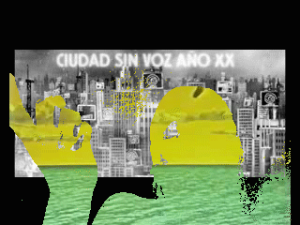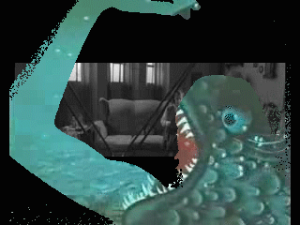This project consists of a series of studies on algorithmic video. They investigate the opportunities for dynamic spatial montage offered by digital video. Found footage excerpts are fed to different algorithms that manipulate the pixels of the videos in real time.
Algorithmic videos SLIT SCAN and TIME SCULPTURE experiment with the temporal dimension of the video. They visualize simultaneously areas of past and future frames of the same video. The projects REAL-TIME VIDEO MIX and TU/TWO investigate interactive ways to compose and mix multiple videos in real time.
REAL-TIME VIDEO MIX
In REAL-TIME VIDEO MIX, areas of a video are replaced by the corresponding areas of another video in real time, according to the selections of the viewer.
Software: C++ (OpenFrameworks).
Found Footage: Dreams by Akira Kurosawa, Outer Space by Peter Tscherkassky
Watch the video: http://www.youtube.com/watch?v=F01_fc4UplI
SLIT SCAN
In SLIT SCAN fragments of past and future frames of the same video are visualized simultaneously. Every horizontal line of pixels visualizes the corresponding pixels of a future frame. This transformation adds fluidity to the forms, freeing them from spatiotemporal constraints.
Software: Processing.
Found footage: ‘Pas de Deux’ by Norman McLaren.
Watch the video: http://www.youtube.com/watch?v=TIXR2_i5FnI
TIME SCULPTURE
In TIME SCULPTURE, pixels of past and future frames of the same video are visualized simultaneously in circular concentric areas around the point selected by the viewer.
Every future frame of the video is placed in a different depth, creating a virtual 3D volume out of 2D video-frames. This way, the time dimension is transformed to a third spatial dimension.
Software: Processing.
Found footage: A fragment of the movie ‘Mirror Mask’ by Dave McKean.
View photos: http://www.flickr.com/photos/peqpez/sets/72157625851973277/
TU/TWO
In TU // TWO the movement of the performer is used to create a dynamic mask that makes areas of different videos, simultaneously visible.
A computer vision algorithm detects the movement of the performer and uses this information to process the image of multiple videos, that are simultaneously reproduced at multiple layers. TU //TWO can be presented both as a performance as well as an interactive installation, permitting the audience to experiment with the influence of their movement on an audiovisual composition.
Developed with: Processing
Found footage: ‘La Antena’ by Esteban Sapir, ‘Baron Prasil’ by Karel Zeman.
Photos: http://www.flickr.com/photos/peqpez/sets/72157625977412098/


You must be logged in to post a comment.